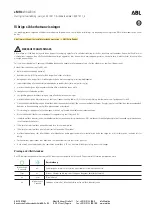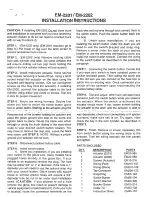
9 ENGINE TUNE-UP
ENGINE TUNE-UP
Engine tune-up is important in maintaining
engine performance, fuel economy, dependabili-
ty, and complete owner satisfaction. Modern high
speed engines demand accurate diagnosis and
adjustments. It is recommended that the engine be
tuned every 5,000 miles.
The tune-up procedure that follows is ar-
ranged in the usual order of performance, which
is generally: compression, ignition, carburetion.
Various manufacturers of testing equipment have
set up specific procedures for their units which
may be followed.
Many of the tests involved in the tune-up are
dependent upon a battery in good condition. If the
battery is below standard it should be recharged,
or replaced with a fully charged battery before the
tune-up.
ENGINE
COMPRESSION
An engine that fails to develop proper com-
pression cannot be tuned. Compression should be
checked with the engine at operating temperature
with a reliable compression gauge. Test is made
with ignition switch off and all plugs removed.
1. Loosen spark plugs to break free any accumulated
carbon.
2. Use an air hose and blow out all dirt and carbon
from spark plug cavities before removing
plugs.
3. Remove all plugs.
4. Insert compression gauge in each spark plug
hole in turn and crack engine with starter at least
4 compression strokes.
NOTE : Check reading on first and final stroke
.
5. Compression at each cylinder should be at least
100 pounds and should not vary more than 10
pounds.
NOTE: If compression gauge moves up in
jerky steps of 10 or 20 pounds at a time, it
generally indicates a sticking or leaking
valve.
valve. If two adjacent cylinders show low com-
pression readings, check for a leaking cylinder
head gasket or loose cylinder head.
To differentiate between ring and valve leak,
place a small quantity of oil on top of each piston
and re-test. Oil will temporarily seal a ring leak
and result in near normal compression. Little or no
improvement will be noted if valve is leaking.
Correct any unsatisfactory condition found
during the compression test before continuing with
the tune-up.
SPARK PLUGS
Upon satisfactory completion of the compression
test, inspect, clean and adjust spark plugs.
1. Spark plugs with burned, blistered or cracked
porcelains, o r with pitted o r burned electrodes,
should be replaced with new plugs of the same
type. For cast iron and aluminum cylinder
heads, use Champion H-8 spark plugs. See
"Electrical Section".
2. Adjust spark plug gaps to .032" using a bending
tool and wire loop gauge.
3. Install new gaskets on the plugs and replace
plugs in cylinder head. Tighten to 25 to 30
pounds with a torque wrench.
4. Examine spark plug wires for loose terminals,
cracked or broken insulation. Replace defective
wires.
Summary of Contents for 1953 Super Jet
Page 1: ......
Page 2: ......
Page 6: ...1 LUBRICATION...
Page 7: ...LUBRICATION 2...
Page 8: ...3 LUBRICATION...
Page 31: ...ENGINE 26 FIGURE 4...
Page 74: ...69 ELECTRICAL SYSTEM...
Page 75: ...ELECTRICAL SYSTEM 70...
Page 78: ...73 CLUTCH...
Page 80: ...75 CLUTCH...
Page 86: ...81 TRANSMISSION...
Page 95: ...TRANSMISSION 90...
Page 98: ...93 OVERDRIVE FIGURE 2...
Page 112: ...107 OVERDRIVE Figure 1...
Page 122: ...117 FRONT SUSPENSION...
Page 130: ...125 STEERINGGEAR...
Page 154: ...REFERENCE Source of Information Date Subject...
Page 155: ......
Page 156: ......















































